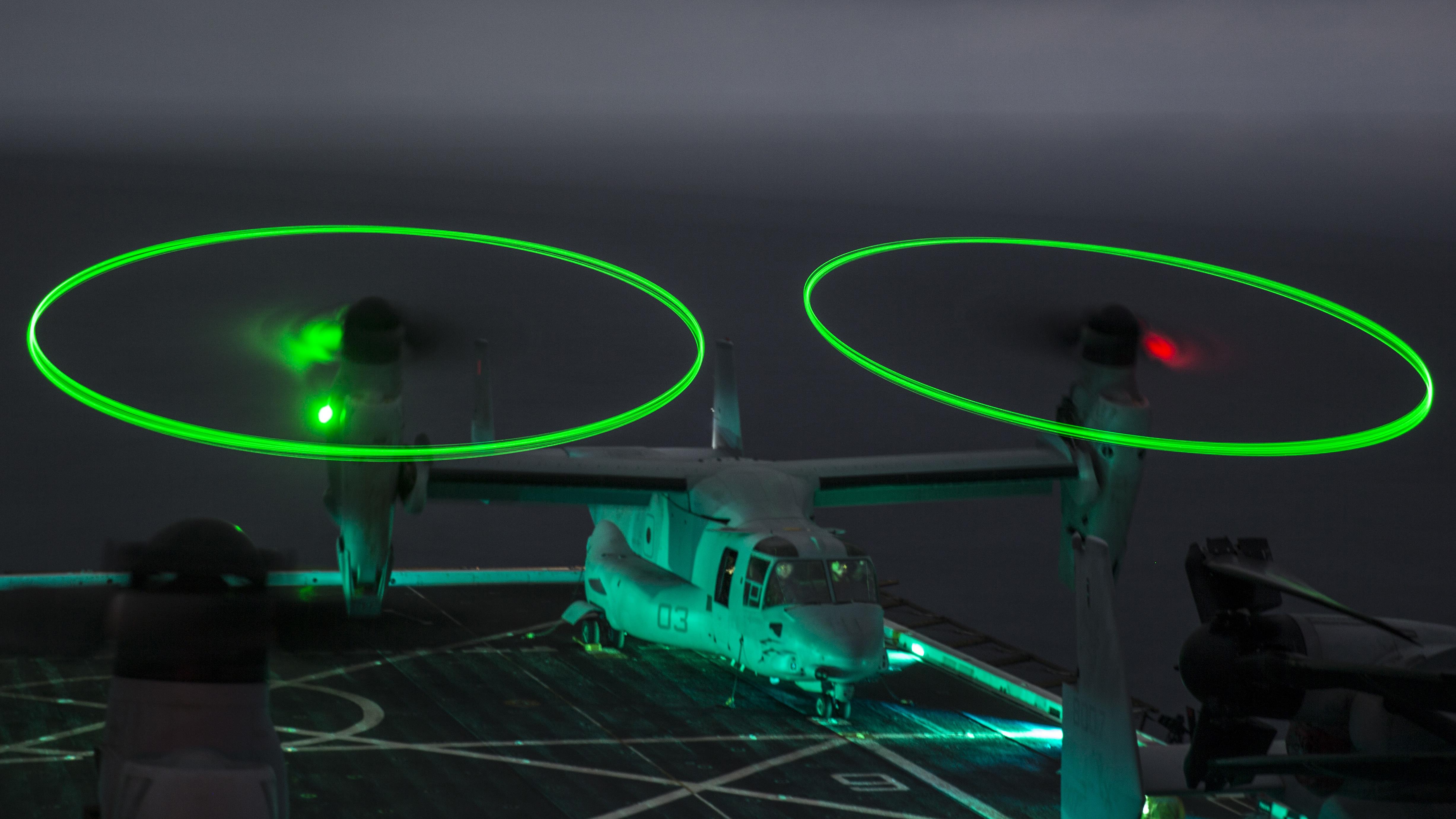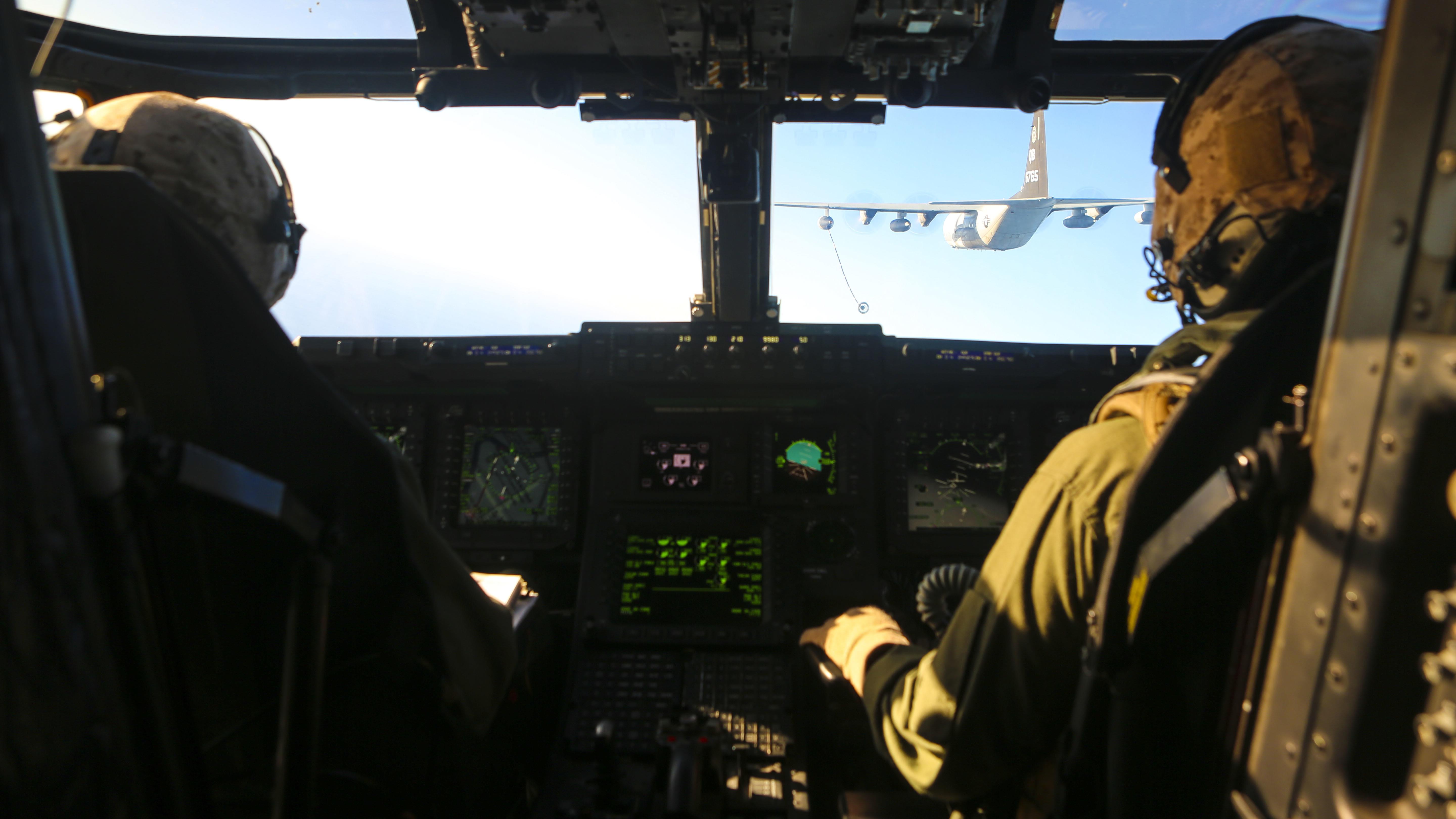Flying & Fighting in the MV-22: Interview with Marines Osprey pilot


The most radical, and controversial, aircraft in frontline service is the V-22 Osprey. Far faster and longer-ranged than a helicopter yet with the same ability to take-off and land vertically, the Osprey is unique. But its critics describe it as vulnerable, costly and dangerous. So what is the view of those who have taken the aircraft into combat? We spoke to Carleton Forsling who flew MV-22s for the United States Marines Corps to find out more.
Note: This blog can only carry on with donations, please hit the donation button and share what you can. Thank you.
“From a commander’s perspective, the speed and range of the Osprey are complete game-changers. Fixed-wing aircraft have always travelled long distances at high speed, but they require airfields to operate. That has always implied a chicken-or-egg scenario–you can’t get troops in without an airfield, but you can’t take an airfield without troops. Before the Osprey, that meant fighting one’s way to get an airfield or other facilities close to the fight or using airborne troops, which have always been incapable of sustaining themselves. Helicopters are notoriously short-ranged and slow. They provided tactical mobility, not operational or strategic mobility. Today, an Osprey can deliver troops hundreds of miles at high speed. It completely changes that paradigm.
From a pilot’s perspective, that is still impressive. For example, when I flew CH-46E Sea Knights, usually called the “Battlephrog,” it took the better part of a week to move helicopters from North Carolina to California for an exercise. With the V-22, it was just a long day. I flew a CH-46E from a ship in the Arabian Sea to Afghanistan in 2001. It was a fairly harrowing trip – at the limits of the machine. When I delivered one of the first V-22s from a ship to Afghanistan in 2009, it was as uneventful as taking a commuter flight from Des Moines to Chicago.
Still, what I most enjoyed about the Osprey was the way it made many of the most demanding tasks in traditional helicopters easy. In a helicopter, especially an older helicopter like a CH-46E, instrument flight was practically an emergency procedure. It was something you avoided. The V-22 was such a good IFR platform we could fly formations through bad weather routinely. In the -46, landing in a brownout was tempting fate each and every time–you just set your deceleration and attitude as best you could and tried to time your landing. In a V-22, you have several options in automation–you can use the electronic display to hand-fly the aircraft to the deck, showing your drift all the way to the ground even if you can’t see it. You can also use it to set up in an automatically stabilized high hover, or HOGE, then let yourself down under computer stabilization. Your choice depends on the tactical situation. It makes the most demanding task in all of military aviation, the brownout landing, into a routine one.
I always expressed my frustration with the Osprey as something along the lines of “We bought a Lamborghini, but didn’t spring for the power locks or a decent stereo.” It was things that the engineers forgot, like making the latches on maintenance panels sturdy enough for the demands of a high-performance machine, or having a GPS not certified for IFR use, or an icing system not up to commercial standards. The big-ticket technology, like the tiltrotor part, worked great. It was the ancillary systems that drove me crazy sometimes.”
Myths
“The biggest myth is that it’s unsafe. I did many tours, airshows, and public-relations appearances with the aircraft. Some people acted as if I was a professional stuntman or something and asked if I felt like I was in danger flying it. Historically, the Osprey suffered greatly, reputation-wise, because senior leaders mishandled its introduction, both in engineering and in aircrew training. In its mature form, it is statistically one of the safest combat aircraft in military service. It has double and sometimes triple redundancy in most of its critical systems. In the event of an engine failure, it can fly all day in airplane mode. In many helicopters, the second engine just takes you to the scene of the crash. I had my share of emergencies in the V-22, just as I did in the Phrog (CH-46), but I was always confident in the airframe to do its job.”

What were your first impressions of the Osprey?
“The first time I saw it was as a CH-46E pilot flying around MCAS New River. It was still in developmental test at the time, and it was something like seeing a pink elephant or something. It was cool-looking, but I never thought much of it. Then I heard about the much-publicized mishaps and disparaged it, just like some of my compatriots.
The programme stopped flying for a couple of years, but when it stood up, some of the lead pilots did a road-show to tell fleet pilots where the program was going. I was an instructor in HT-18, the helicopter training squadron. When I saw their presentation, I was impressed. When the message came out asking for applications to fly it, I jumped right on it.”
Is it reliable?
“I won’t lie and say it isn’t a bit finicky. I like to say it’s a Lamborghini, but perhaps it’s best likened to a Porsche Panamera. It ain’t a Honda Accord. It takes more to keep it going, but it gives a lot more too. It’s a much more avionics-intensive machine. In fact, one of the problems we encountered early on is that the squadrons were structured very much like an old helicopter squadron in terms of the numbers of airframes mechanics, power line (or “flight line” in Marine-speak) mechanics, and avionics technicians assigned. In reality, most problems with the Osprey came down to electronics, and gradually the Corps readjusted to that.”

“It does have the complexities of both a helicopter and a fixed-wing aircraft. Helicopters have a lot of hour-limited components, as does the Osprey. It does take a lot of work, I won’t lie about that. Many maintainers who switch to the Osprey aren’t pleased at first, but eventually most grow to love it, just like any other aircraft.
Another thing to remember is that the aircraft is incredibly self-aware. Whereas in a traditional aircraft, the first indication of a system degradation is an in-flight emergency, in the Osprey almost every parameter is recorded every flight. That means that problems are spotted before they affect the safety of flight and can be fixed before a system fails, not after. That’s a huge step up from legacy aircraft”

Is it too fast to be used to its greatest potential with helicopters?
“That depends. It’s a mistake to treat it like a legacy aircraft, and during the fleet introduction, a lot of pilots were frustrated by senior leaders who treated it like just a slightly faster version of the CH-46. During exercises, we’d park the amphibious ships just a couple of miles from the beach, so that the V-22s barely had a chance to transition from helicopter, or “VTOL,” mode, before touching down in an LZ. If we employ it that way, then it is truly just an overly-expensive rotorcraft.
If we employ it they way it was designed, though, it can achieve things that no helicopter can. There are a variety of ways to achieve that synergy. If I had (several) billion dollars, I’d invest in high-speed escorts, perhaps even in heavily-armed V-22s to achieve that. In today’s world, though, there are still many ways to exploit the Osprey’s assets while still supporting troops in an LZ. That can come from using armed rotorcraft from FARPs (Forward Arming and Refueling Points). It can come from synchronizing V-22s with fixed-wing escorts. And it can be done by using V-22s to land where the enemy isn’t, because he can’t be anywhere, and the V-22 gives commanders the opportunity to “hit him where he ain’t.”
Have a look at 10 Best fighters of World War II , top WVR and BVR fighters of today, an interview with a Super Hornet pilot and a Pacifist’s Guide to Warplanes. Was the Spitfire overrated? Want something more bizarre? The Top Ten fictional aircraft is a fascinating read, as is The Strange Story and The Planet Satellite. The Fashion Versus Aircraft Camo is also a real cracker. Those interested in the Cold Way should read A pilot’s guide to flying and fighting in the Lightning. Those feeling less belligerent may enjoy A pilot’s farewell to the Airbus A340. Looking for something more humourous? Have a look at this F-35 satire and ‘Werner Herzog’s Guide to pusher bi-planes. In the mood for something more offensive? Try the NSFW 10 best looking American airplanes, or the same but for Canadians.
Is it particularly vulnerable to ground-fire?
“Like any rotorcraft, it’s not invulnerable. Movies sometimes give the impression that some helicopters can be rendered invulnerable to small-arms fire. Other than critical systems, it’s impossible to protect helicopters from holes being punched in them if they’re hit.
The biggest defense against battle damage is to avoid being hit in the first place. The Osprey is unique among assault aircraft in this regard. Enroute, it flies faster than helicopters, making it harder to hit. It also can fly either a low altitude or high altitude profile, depending on the MANPAD threat.
It is also far more maneuverable than traditional rotorcraft. Some people mistake being able to shake the controls around for maneuverability. Maneuverability means being able to move an aircraft’s velocity vector quickly in multiple axes. That’s something the Osprey can do better than any helicopter I’m familiar with. The Osprey can displace from a threat vertically and horizontally. In helicopters, the solution is just to fly lower, and there’s certainly a lower limit on altitude!”
 “If it does get hit, the Osprey has multiple redundant systems. That’s true for its engines, hydraulics, and key electronics. Its fuel tanks are self-sealing and fill with inert nitrogen as they empty to prevent fires. The pilots’ control inputs are transmitted to the control surfaces by electrons, not rods and cables. The troop seats stroke to reduce the impact in the event of a crash. Those features are what truly help troops survive in combat.”
“If it does get hit, the Osprey has multiple redundant systems. That’s true for its engines, hydraulics, and key electronics. Its fuel tanks are self-sealing and fill with inert nitrogen as they empty to prevent fires. The pilots’ control inputs are transmitted to the control surfaces by electrons, not rods and cables. The troop seats stroke to reduce the impact in the event of a crash. Those features are what truly help troops survive in combat.”
What is your most memorable flight on the aircraft, what is it like to fly?
“Most memorable? Well, there was this time when I flew though the wake of my lead aircraft while turning and descending on a base leg and it nearly flipped us over. We recovered at 47′. That phenomenon has to do with the strong rotorwash due to the high disk loading of the V-22, which leaves disturbed air behind a lead aircraft and the way the fly-by-wire system holds an attitude for the dash two. After this incident, the Marine Corps changed the parameters for where the dash two aircraft should be relative to the lead aircraft while descending in conversion (helicopter) mode. In my personal opinion, this wake interaction was what caused the Marana mishap, not the infamous “Vortex Ring State.
As far as what it’s like to fly, it’s like nothing else. It accelerates and decelerates incredibly quickly and is extremely maneuverable for a big aircraft at both high and low speeds. It’s also remarkably stable. Hovering is a breeze–to the point that fixed wing pilots transitioning to the V-22 ask what the big deal is when helicopter pilots talk about hovering. It’s also an amazing instrument platform.”

What do you believe is the future for the V-22 and tilt-rotors in general?
“I think that tiltrotors have a very bright future. When I look at the information on the upcoming Bell V-280, it really looks as if they taken the lessons of the V-22 and taken it to the next level.”

“As long the military has a need for crisis response, there will continue to be a need for tiltrotors.
The biggest challenge will be whether tiltrotors are accepted in commercial aviation. The operating cost will have to come down for it to become viable in EMS, petroleum, and executive transport. The military doesn’t have to turn a profit. Civilian operators do.”
Does it have a nickname?
“The Osprey hasn’t gotten a cool second nickname like some other aircraft, like the CH-46 SeaKnight, which became the ‘Phrog,’ or the CH-53, which became the ‘Shitter.’ Occasionally you’ll hear someone call it the ‘Plopter’, but it really hasn’t caught on, except as an occasional joke.”
Any advice to those working with the Osprey?
“Try to keep up. Seriously, though, my guidance for those planning to fly with the Osprey is to begin your mission planning with a clean sheet of paper. The Osprey isn’t a helicopter that flies fast. It’s an airplane that can land vertically.
The biggest mistake you can make is to treat it like just another rotorcraft. Whether that means you fly unescorted and use operational surprise, whether you coordinate a time-on-target CAS or artillery strike, use detached escort, etc…that’s all situationally dependent. The flexibility of the Osprey is one of its biggest assets, but it’s also a challenge for planners who’ve worked under the same paradigm for a long time.”

What equipment would you like to see fitted to the MV-22?
“I’m not even as creative as the Bell-Boeing developers right now. Anything that could be installed on a light cargo aircraft can be put on an Osprey. Of course, the vertical landing capability means that those capabilities can be brought to environments that didn’t have them before, e.g. off amphibious ships and out of remote forward operating bases.
I think the MV-22 is capable of doing many of the tasks the Air Force AC-130 and the Marine Corps Harvest Hawk KC-130 aircraft are doing. It is definitely capable of providing close air support and other fires, especially in a low-threat environment.
Additionally, it’s supremely well-suited for other utility missions, e.g. command and control, surveillance, electronic warfare, and aerial refueling. The sky is the limit. It could be a drone mothership, an AWACs or E-2 type battle manager, whatever you want.
The big issue is not the technical feasibility of these, but investing in the resources to train pilots and aircrew in not just their primary assault support missions, but also the additional missions the Osprey is capable of.”

How did the MV-22 do in Afghanistan- what were the biggest challenges and most notable missions?
“The V-22 built on the lessons learned in Iraq when it went to Afghanistan. It became more of a mainstay of Marine Corps assault support in Afghanistan, vice just a sideshow.
To be honest, neither conflict was one at which the Osprey was really going to demonstrate decisive advantages over helicopters. When there’s already a network of forward operating bases and the distances involved are relatively short, the Osprey’s advantage over traditional rotorcraft is reduced when compared to an amphibious assault or long-range crisis response scenario.
However as the war in Afghanistan wound down, the Osprey became a great platform for casualty evacuation. As the Marine Corps started to shut down FOBs, and the distances to medical facilities became greater, the “golden hour” could still be maintained. Helicopters couldn’t do that.”
Carl is the Senior Columnist for Task and Purpose

Carleton Forsling
You may also enjoy A B-52 pilot’s guide to modern fighters, Flying and fighting in the Lightning: a pilot’s guide, Interview with a Super Hornet pilot, Trump’s Air Force Plan, 11 Worst Soviet Aircraft, 10 worst US aircraft, and 10 worst British aircraft

” It became more of a mainstay of Marine Corps assault support in Afghanistan”
Really? We never had more than ten there, and half were always down. We brought in old, old CH-53Ds that did a much better job.